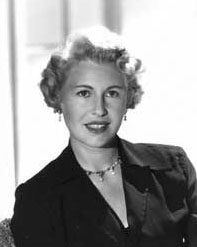The Hollywood gossip columnist Sheilah Graham, born Lily Shiel, shaped herself out of nothing much, and she knew it. As her eight memoirs attest, she also knew how remarkable the story of her self-reinvention was—especially the three and a half years she spent as F. Scott Fitzgerald’s companion and lover, until he died on her green living room carpet in December 1940. Her 1967 memoir College of One, reissued as part of Melville House’s Neversink Library, tells the story of the couple’s relationship through their shared project of educating Sheilah, via a one-woman intellectual boot camp devised by Fitzgerald, “for a woman who had to learn in a hurry.”
Graham’s desire for education is rooted at first in shame and fear. Shame: that she can’t keep up with the intellectual conversation of the people she gets to know in London, New York, and Hollywood, the likes of Dorothy Parker and Robert Benchley and Mary McCarthy, who drop names she doesn’t recognize and assume a knowledge she doesn’t share. Fear: that she’ll be exposed, humiliated, and banished back to where she came from. It isn’t until she’s deep into her curriculum that she begins to enjoy the reading and discussion for its own sake, rather than out of a class anxiety so palpable it’s painful to read. Even Graham’s success in Hollywood is driven by her sense of shame—she goes west from New York with relief, to a town “notorious” for its ignorance: “I would be comfortable there. No one could embarrass me with erudite conversation.”
Lily Shiel grew up in an orphanage in the east end of London, her thick hair regularly shaved to prevent lice, and the eager brain underneath stuffed with homilies, Bible verses, and historical simplifications that promoted an allegiance to God and King. It was an upbringing that erased her identity as the child of Jewish refugees from the Ukraine, and shaped her into an obedient daughter of the English working class, terrified of anarchy and unions, and accepting of an unjust status quo. Her father had died when she was very young and her mother, too poor to cope, placed her two youngest children in the orphanage. When Lily graduated at fourteen, her education was over: she was needed at home, and it wasn’t until her mother died a few years later that Lily moved to the West End of London and made her way onto the stage, via shop work and marriage to a much older man, who smoothed out her accent and groomed her, if not quite for stardom, then at least for survival.
Many years later, in Hollywood, the lowest moment of Graham’s relationship with F. Scott Fitzgerald came when he threw her secret origins in her face, screaming that she was a Jew in front of the nurse who had been hired to see him through the aftermath of a titanic gin binge. This ugly detail is softened in the memoir (Graham says only that he revealed her “humble beginnings”) but is stripped of euphemism in the afterword by Graham’s daughter Wendy Fairey. It’s the starkest example of the memoir’s pattern of revelation and evasion in its depiction of Fitzgerald, who appears by turns as generous and self-interested, loving and narcissistic, hopeful and nihilistic.

Graham early on shrugs and accepts the power imbalance of a male Svengali educating a beautiful protégée. Long before she meets Fitzgerald, she says she has learned “that men who are in love are not interested in whether the girl knows an A from a B at the beginning of the relationship”—and suggests that perhaps they prefer it that way. Scott himself, she says, likens his education of Sheilah to what “Irish and Scotch pioneers who had struck it rich in the West had done, importing peasant girls to marry.” Not that the two can marry, with Zelda still alive in a distant asylum, haunting Sheilah’s nightmares. The education becomes a bond that stands in for, and later transcends, that missing marriage.
The curriculum of the College of One, described in detail and reproduced in a neatly typed appendix, is eclectic, demanding, and innovative. Fitzgerald is a firm historicist, assigning novels and poems as illustrations of an era as Graham works her way through the thousand pages of H.G. Wells’ Outline of History. He helps her through Shakespeare by assigning her “bridges” of famous passages to memorize in advance and then watch out for as she reads, and professor and pupil act out scenes from novels, plays, and poems. He constantly revises the curriculum, giving it to his long-suffering secretary to re-type. It would be hard not to see the whole thing as a masterly form of procrastination—Fitzgerald was dragging his heels on The Last Tycoon at the time—were it not for the joy and peace that it clearly gave him in the last year of his life. Graham, too, makes clear at the end of the book that she has moved beyond shame to a prouder, more positive understanding of her education, shifting from the past to the present tense as she declares: “It widened my horizon. I know where to look. I know how to evaluate. I am curious.”
As a writer, Graham is plain and conversational, and her story often meandering and anecdotal. But her modest style makes the defining moment of Fitzgerald’s death—right in the middle of the music course—land the more powerfully for its understatement:
It was a strange coincidence that he asked me to play [Beethoven’s] Eroica Symphony while he was making some notes about football on the Princeton Alumni Weekly. Soon after it ended, Scott suffered his fatal heart attack. There was still an echo of the music in the room with the afternoon sun through the venetian blinds making patterns on his pale face on the dark green carpet.
Perhaps only at a distance of twenty-six years can something so shocking be described with such elegant detachment—and perhaps only by the most diligent student of F. Scott Fitzgerald.




